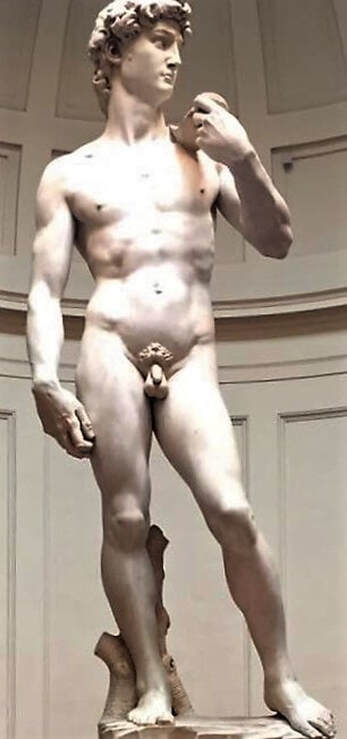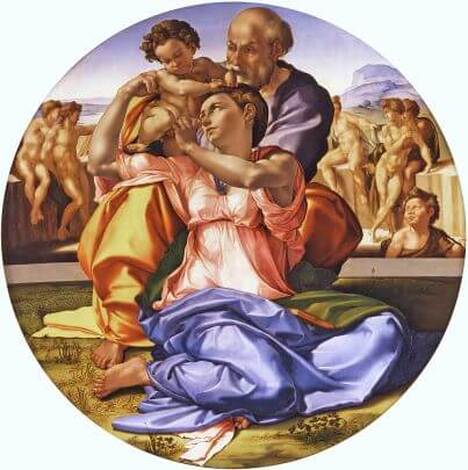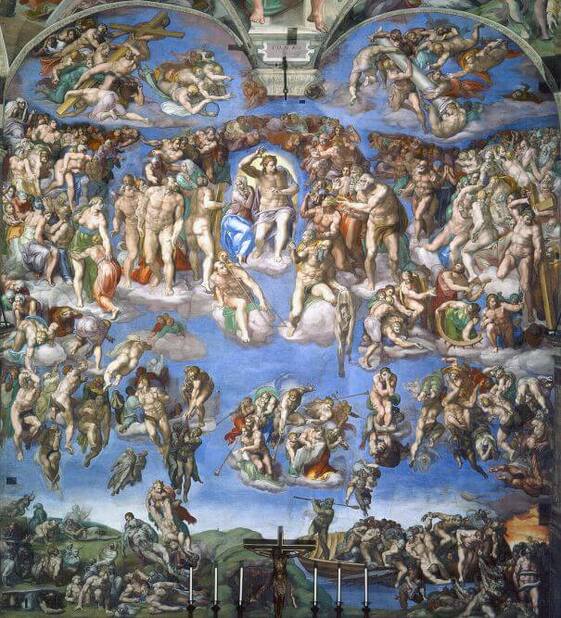The figures surrounding God: God is surrounded by twelve figures, which are identified as angels. However, the figure under the left arm of God stands out as she seems to be different. It is actually a woman and it is not clear who she is. Some have suggested that this is a female angel, others suggest that this is Eva, and even others suggest that she is the bride of God.
The left hand of God also touches one of the angels. This angel has been suggested to starkly resemble Baby Jesus in the Doni Tondo (in the Uffizi Museum), and may thus be God’s idea for the creation of Jesus. If this is true, then this painting also symbolizes the future coming of Jesus to reconcile the sins of Adam and his descendants.
Backstory: This painting is based on the biblical story in Genesis 1:26-27: “And God said, “Let Us make man in Our image, after Our likeness; and let them have dominion over the fish of the sea, and over the fowl of the air, and over the cattle, and over all the earth and over every creeping thing that creepeth upon the earth. So God created man in His own image, in the image of God created He him; male and female created He them.”
When reading this story in the Bible, many people have this image of Michelangelo in their minds. Michelangelo painted this fresco near the end of his work on the ceiling, which contains, among other things, nine scenes from the book of Genesis. However, the Creation of Adam has become the most memorable part of the series of frescos on the ceiling. Who is Michelangelo? Michelangelo di Lodovico Buonarroti Simoni (1475-1564) was born in Caprese in the Republic of Florence. He was a painter, sculptor, poet, and architect and he has had an enormous influence on the development of art. Some consider him the greatest artist ever, but he is certainly considered to be one of the four most important artists of the Renaissance, together with Donatello, Leonardo da Vinci, and Raphael. During his life, Michelangelo was considered to be the best artist on earth and earned the nickname Il Divino (the divine one). During his time in Rome with Pope Julius II, he painted the ceiling of the Sistine Chapel all by himself. It took him four years (1508-1512) to complete this ceiling, which is now considered to be one of the best frescos ever created. He also created The Last Judgment on the wall of the Sistine Chapel, which is also a very famous fresco.
Fun fact: In 1990, Frank Meshberger, a gynecologist, wrote a paper in the Journal of the American Medical Association claiming that the red background behind God and his entourage represents an anatomically correct image of the brain. This interpretation implies that this painting shows not only the gift of life by God but also the gift of intellect. He describes that Adam is already alive in this fresco and the real effort of God to touch Adam would be to give him a brain with intellect.
While many people are not completely convinced by this interpretation, it is not entirely unlikely. Michelangelo often dissected corpses to get a better understanding of human anatomy and he would thus have known how a human brain would look like. In addition, some of the sonnets that Michelangelo wrote also discuss the important role of the intellect of human beings. Another interpretation of the red background that gained some traction is that it is a depiction of a uterus and that this fresco symbolizes fertility. Interested in a copy for yourself? Poster of canvas (Amazon links)
Written by Eelco Kappe
References:
0 Comments
Leave a Reply. |
Categories
All
|
- Home
- Blog
-
Museums
- Alte Pinakothek
- Art Institute of Chicago
- Baltimore Museum of Art
- Barber Institute of Fine Arts
- Bargello
- Barnes Foundation
- British Museum
- Church of Sant’Anastasia
- Cleveland Museum of Art
- Courtauld Institute of Art
- Detroit Institute of Arts
- Frans Hals Museum
- Galleria Borghese
- Gallerie dell'Accademia
- Getty Museum
- Guggenheim
- Hermitage Museum
- Kunsthistorisches Museum
- Kunstmuseum Basel
- Legion of Honor Museum
- Louvre
- Mauritshuis
- Metropolitan Museum of Art
- Musee d’Orsay
- Museum of Fine Arts in Boston
- Museum of Modern Art
- National Gallery in London
- National Gallery of Art
- National Museum in Poznań
- Norton Simon Museum
- Ny Carlsberg Glyptotek
- Palace of Versailles
- Palazzo Pitti
- Palazzo Vecchio
- Petit Palais
- Philadelphia Museum of Art
- Prado
- Pushkin Museum
- Ravenna Art Museum
- Rijksmuseum
- San Diego Museum of Art
- Santa Maria delle Grazie
- St. Peter's Basilica
- Städel Museum
- Statens Museum for Kunst
- Tate Britain
- Tate Modern
- Timken Museum of Art
- Uffizi
- Vatican Museums
- Wallace Collection
-
Artists
- Altdorfer
- Anguissola
- Berlin Painter
- Bosch
- Botticelli
- Boucher
- Bronzino
- Bruegel the Elder
- Brunelleschi
- Cabanel
- Caillebotte
- Canova
- Caravaggio
- Carpeaux
- Cezanne
- Cimabue
- David
- Degas
- Delacroix
- De Maria
- Donatello
- El Greco
- Fontana
- Fra Angelico
- Fragonard
- Gauguin
- Gentileschi
- Gericault
- Gonzalez-Torres
- Goya
- Hals
- Hogarth
- Hokusai
- Ingres
- Leonardo da Vinci
- Lippi, Filippo
- Longhi, Barbara
- Lorrain
- Makovsky
- Manet
- Massys
- Matisse
- Merian
- Michelangelo
- Mochi
- Modigliani
- Monet
- Panini
- Parmigianino
- Perugino
- Picasso
- Pisanello
- Raphael
- Rembrandt
- Renoir
- Reynolds
- Rivera
- Rodin
- Rubens
- Scultori
- Seurat
- Steen
- Tintoretto
- Titian
- Toulouse-Lautrec
- Turner
- Uccello
- Van der Weyden
- Van Dyck
- Van Eyck
- Van Gogh
- Van Hemessen
- Vasari
- Velazquez
- Vermeer
- Veronese
- Vigée Le Brun
-
Locations
- Books
- About Us




